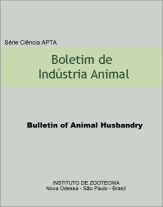QUALITY OF CORN SILAGE INTERCROPPED WITH TROPICAL GRASSES AT DIFFERENT ROW SPACING
DOI:
https://doi.org/10.17523/bia.v74n3p237Keywords:
forages, animal nutrition, wet grain silage, Zea mays.Abstract
The search for pasture alternatives in livestock farming has focused on options that maximize soil use without exhausting its chemical and physical qualities. Integrated crop-livestock systems (SIPA in the Portuguese acronym) have called the attention of producers since they are economically and ecologically viable. The objective of this study was to measure the influence of corn plant spacing (0.45 and 0.90 m) in forage intercrops (Xaraes or Tanzania grass) on the quality of wet grain silage. A random block design in a 2 x 2 factorial scheme was used, with eight repetitions consisting of the following treatments: corn planted at a row spacing of 0.45 m and intercropped with Xaraes grass; corn planted at 0.90 m and intercropped with Xaraes grass; corn planted at 0.45 m and intercropped with Tanzania grass, and corn planted at 0.90 m and intercropped with Tanzania grass. The contents of dry matter percentage, crude protein, neutral and acid detergent fiber, lignin, cellulose, hemicellulose and soluble carbohydrate and buffering capacity were determined before ensiling and in silage. Ether extract, neutral/acid detergent insoluble nitrogen, ammoniacal nitrogen, pH and in vitro dry matter digestibility were only evaluated in silage. All intercropping modalities studied (forages and spacing) were viable, providing wet grain silage of good quality. However, intercropping of corn with Tanzania grass at a spacing of 0.90 m resulted in higher ether extract content, lower lignin content, and greater digestibility.Downloads
Downloads
Published
Issue
Section
License
Os autores não serão remunerados pela publicação de trabalhos, pois devem abrir mão de seus direitos autorais em favor deste periódico. Por outro lado, os autores ficam autorizados a publicar seus artigos, simultaneamente, em repositórios da instituição de sua origem, desde que citada a fonte da publicação original seja Boletim de Indústria Animal. A revista se reserva o direito de efetuar, nos originais, alterações de ordem normativa, ortográfica e gramatical, com vistas a manter o padrão culto da língua e a credibilidade do veículo. Respeitará, no entanto, o estilo de escrever dos autores. Alterações, correções ou sugestões de ordem conceitual serão encaminhadas aos autores, quando necessário. Nesses casos, os artigos, depois de adequados, deverão ser submetidos a nova apreciação. As opiniões emitidas pelos autores dos artigos são de sua exclusiva responsabilidade. Todo o conteúdo deste periódico, exceto onde está identificado, está licenciado sob a Licença Creative Commons Attribution (CC-BY-NC). A condição BY implica que os licenciados podem copiar, distribuir, exibir e executar a obra e fazer trabalhos derivados com base em que só se dão o autor ou licenciante os créditos na forma especificada por estes. A cláusula NC significa que os licenciados podem copiar, distribuir, exibir e executar a obra e fazer trabalhos derivados com base apenas para fins não comerciais.













